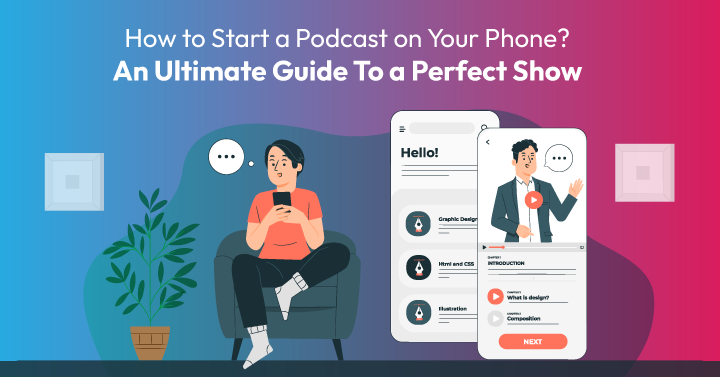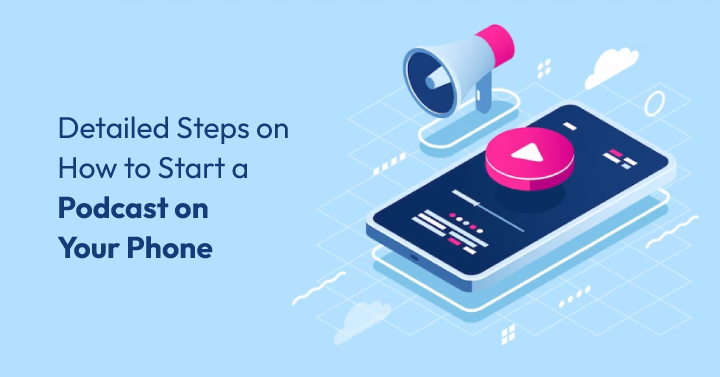
As a novice who’s making forays into the podcasting world, it’s always smarter to start small and then proceed. Many people believe that starting a podcast requires costly equipment, professional recording studios, and a team of sound technicians. However, with just your smartphone, you can create, record, edit, and publish a podcast entirely on your smartphone. So how to start a podcast on your phone?
In this ultimate guide, we’ll walk you through the step-by-step process from choosing the best podcast recording app to publishing and promoting your podcast so you can confidently share your voice and connect with your audience.
1. Detailed Steps on How to Start a Podcast on Your Phone

Step 1: Planning Your Podcast
- Identifying your Target Audience
Think about who your target audience is and what topics would interest them. Consider their age, gender, location, and interests to help narrow your topic options. Conduct surveys, focus groups, or online polls to gather information about your potential listeners. Based on your research, create listener personas that represent your ideal audience.
- Choose a Topic
Start by identifying your areas of interest, hobbies, or expertise. Think about what you enjoy talking about, what topics you’re knowledgeable about, and what excites you. Do some research to see what types of podcasts are popular in your niche or areas of interest. Look at the top charts on podcast platforms, read industry blogs, and listen to other podcasts in your niche to see what topics they cover.
- Structure the Podcast
Planning out the structure of your podcast episode is one of the crucial steps to starting a podcast on your phone. It can help you stay organized and focused and ensure your content is engaging and easy to follow. Based on your topic, list the main points you want to cover in your episode. Focus on what your audience would find interesting or valuable and how you can provide value to them.
- Develop a Podcast Format
After you have your main points, break them down into segments you can cover logically. This will help you stay on track and ensure your episode flows smoothly. You can create a strong introduction that will capture your listeners’ attention and explain what they can expect to learn from your episode. Likewise, conclude your episode with a summary of the main points you covered and a call to action to encourage your listeners to engage with you further.
Step 2: Recording and Editing the Podcast
- Choose Your Gear
Before recording on your phone, you must have all the sound equipment and software necessary to ensure your podcasts sound professional- You need a smartphone and a good microphone when starting a podcast on your phone. Ensure your microphone is adequately set up with headphones or earphones.
- Setup a Recording Environment
Choose a room or area where you can avoid external noise, such as traffic, people talking, or music playing. If you’re recording in a room with hard floors and walls, place a rug or some blankets around you to absorb sound and minimize echo. Before you start recording, adjust your phone’s settings to ensure that you’re getting the best possible sound quality. Turn off any unnecessary apps, close any open windows or tabs, and set your phone to airplane mode to avoid interruptions.
- Record and Edit Your Podcast
Choose the right podcast app for recording and editing your podcast episodes. Some popular podcasting apps include Anchor, Buzzsprout, Spreaker, and Podbean. Make sure the app you choose should have essential editing tools such as trimming, cutting, and fading and advanced features such as noise reduction, equalization, and compression.
Step 3: Upload & Publish Your Podcast
- Choose a Hosting Platform
Choose a hosting platform to publish your podcast. You can use your podcasting apps, such as Anchor, SoundCloud, and Podbean, to upload and publish your podcast on multiple hosting platforms. Sign up for a podcast hosting service, log in to your podcast hosting account from the mobile app, and upload your finished episode.
- Add a Suitable Title and Description
Add a suitable title and description to your podcast before publishing. Your podcast description should provide an overview of what listeners can expect from your show. It’s important to optimize your title and description for search engines. Use relevant keywords in your title and description before you publish the podcast Make sure the description is long enough to provide sufficient information.
- Submit your Podcast to Directories
Most hosting platforms will provide you with a link to your podcast RSS feed, which can be submitted to popular podcast directories such as Apple Podcasts, Spotify, and Google Podcasts. This will make your podcast available to a broader audience.
Step 4: Promote Your Podcast
- Share your Podcast on Social Media
Promoting your podcast from your phone can be a convenient and effective way to reach new listeners and grow your audience. One of the easiest ways to promote your podcast is by sharing it on social media. You can use your phone to post updates, teasers, and links to your latest episodes on platforms like Twitter, Facebook, Instagram, and LinkedIn. You can also create short clips or visual content that promotes your podcast and share it on social media.
- Build Authority Through Networking
Collaborating with other podcasts in your niche is another effective way to reach new listeners and promote your show. You can directly contact other podcast hosts and propose a collaboration, such as guest appearances, cross-promotion, or joint episodes. Attend conferences, seminars, and other industry events where you can meet other professionals in your field. This is a great way to build relationships, share ideas, and get exposure for your podcast.
- Monitor the Metrics
Monitor your podcast analytics to track your progress and improve your content. Check your listener numbers, reviews, and feedback to get insights into your podcast’s performance.
Reviews and ratings on platforms like Apple Podcasts and Spotify can be valuable metrics to track, as they provide feedback on the quality and value of your podcast.
- Monetize your Podcast
Monetizing your podcast can be a great way to turn your passion for podcasting into a profitable venture. Some of the ways to monetize your podcast include – sponsorship, affiliate marketing, merchandise, and crowdfunding. You can also offer additional content or exclusive access to your podcast for a fee. This can include bonus episodes, early access to episodes, or access to a private community.
2. Bonus Step: Testing the Browser for Recording and Hosting
If you don’t want to use the app, you can record and publish your podcast using a web browser such as Chrome or Safari. In that case, testing your browser before you start recording and publishing your content is essential. Check if your browser is compatible with the podcast recording and hosting platform you plan to use.
Most platforms, such as Anchor or Zencastr, provide information on their website regarding the compatible browsers with their software. You should also check if the browser allows for file formats such as .mp3 or .wav, commonly used for podcasts.
Once you’ve confirmed browser compatibility, test your microphone to ensure it’s working correctly. Most browsers, such as Google Chrome, will ask permission to access your microphone when you visit a website requiring audio recording. Click on “Allow” or “Grant Permission” to enable access to your microphone.
Additionally, research tools and services will allow you to host your audio files reliably. Once all of the components have been tested and checked, you can begin recording with confidence that everything works perfectly together.
3. FAQs
- Can I Start a Podcast With My Phone?
Yes, you can start a podcast with your phone. You only need a smartphone with a good microphone, a podcasting app, and essential accessories like headphones and a pop filter to improve your audio quality.
- How Do You Start a Podcast from Your Phone for Free?
You can start a podcast from your phone for free using a podcasting app that allows you to record, edit, and publish your podcast directly. Some popular options include Anchor, Spreaker Studio, and Podbean.



